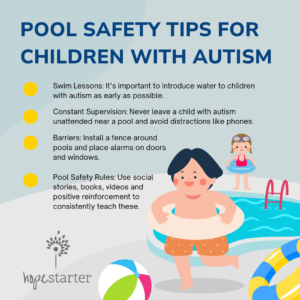A cool splash feels amazing on a hot summer day. But for individuals with autism, water is both a relief and a danger.
Drowning is a leading cause of death for children with autism, who are 160 times more likely to drown than people who do not have autism.
Because of the heightened risk, some experts recommend that children diagnosed with autism receive swimming lessons in addition to other, evidence-based interventions.
Why children with autism tend to be attracted to water
Many people with autism are drawn to water, because it provides a number of sensory rewards. The gentle lapping or trickle of moving water can be incredibly soothing. Watching light reflect on water can be mesmerizing and relaxing. The buoyancy of water provides a gentle, supportive pressure that can be calming and grounding.
And swimming can be a fantastic activity for people with autism, offering a range of benefits for both physical and emotional well-being.
Swimming also helps with proprioception, which is often a challenge for people with autism.

It’s important to balance the benefits of swimming with the need for safety.
Swimming safety for children with autism
Here are some tips for keeping people with autism safe around swimming pools:
- Swim Lessons: It’s important to start these as early as possible. Many swim schools offer private lessons which can be adapted for individuals with autism. Swim AngelFish also offers videos with tips and tricks for teaching swimming to children with autism. The program also offers a downloadable, printable water safety toolkit.
- Constant Supervision: Never leave a child with autism unattended near a pool, even for a moment. A wandering child can quickly end up in the water.
- Barriers: Install a fence with a latching gate around the entire pool. Pool alarms can provide an extra layer of security, but shouldn’t replace constant supervision.
- Pool Safety Rules: Teach pool safety rules early and consistently. Use visuals and social stories to help children understand the importance of staying out of the pool without an adult. The Autism Society and HollyRod Foundation collaborated to offer free social stories that teach water safety. And poolsafely.gov has a list of children’s books that focus on water safety.
- Life Jackets: Consider using life jackets around the pool, even if your child is learning to swim.
- Minimize Drinking: Children with autism sometimes like to drink the pool water. Use positive reinforcement to decrease this behavior, or consider offering a chew toy while in the pool.

Know the signs of drowning
Parents and caregivers should become familiar with the signs of drowning. Children can drown in seconds, so it’s important to recognize the danger as soon as possible. Some signs include:
- Hyperventilating or gasping
- Head tilted back with mouth open
- Mouth at or below surface of water
- Head bobbing up and down in the water
- Person is quiet or unable to call for help
- Vertical in water with little leg movement
- Eyes are glassy or closed
- Hair covering face
More Resources:
- Autism Parenting Magazine has an article on the benefits of swimming for children with autism.
- Here is a flyer for the Spectrum Sea Turtles, a a swimming program for adolescents and adults with autism that meets at the Rappahannock Area YMCA
- Rappahannock Area YMCA will have a Special Needs Splash at Thurston Water Park on July 28
- There is a Sensory Swim each Sunday from 3-4 p.m. at the Caroline YMCA


